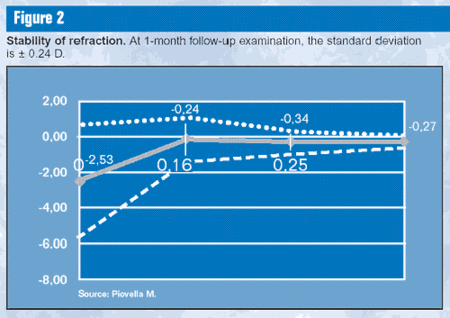New solid-state laser for refractive surgery enters clinical phase
The LaserSoft is showing promising results with LASIK and PRK and may have potential applications for custom ablation.
Click Here to Manage Email Alerts
LaserSoft, a new diode-pumped all-solid-state UV laser for refractive surgery recently introduced by Katana Technologies GmbH, is an intriguing novelty in refractive surgery. The initial results with this new technology appear to be promising, with upcoming applications for custom ablation.
Description
 Source Piovella M. |
A sequential frequency conversion with nonlinear crystals shifts the wavelength of the laser radiation into a range between 208 nm and 210 nm. The CW-diode pumping of the solid-state laser medium leads to very stable shot-to-shot and long-term stability of the UV output. The resonator structure and the beam delivery ensure emission of the laser radiation with a true gaussian beam, providing an excellent UV light spot distribution on the cornea, without the need for beam-forming elements in the beam path. The ablation pattern used in LaserSoft with accurate overlap of true gaussian spots ensures an extremely homogeneous corneal surface.
The LaserSoft generates a flying spot of 0.2 mm in diameter, operating at a repetition rate of 1 kHz. This very small spot size fits the current requirements for effective custom ablation.
The adopted ablation profiles are designed to preserve the strongly aspherical feature of cornea in order to minimize induced spherical aberration. Different reflection losses and fluence values for different angles of incidence of the ablating laser radiation during surgery are also taken into account in the ablation algorithm. The solid-state laser appears to be a promising solution for refractive surgery, applying less energy to the cornea, thus with the theoretical potential of inducing less scarring.
A solid-state laser means much less maintenance and thus less surgical performance variability. There is no gas exchange and gas discharge, which may lead to instabilities in the output radiation due to the physical nature of the discharge process. The solid-state approach reduces the requirements for maintenance and the related costs, and the diode pumping system features long lifetime and efficiency.
LaserSoft features an eye-tracker with a 1-ms latency, thus monitoring the ablation centration at high repetition rates. This very fast eye tracker ensures a reliable, high repetition rate centration of ablation on the X and Y axes as well as the ocular rotation.
Due to the high repetition rate (1 kHz) and small spot size, the energy per pulse is lower than in standard excimer treatments. This leads to an ablation with greatly reduced stress waves. This also means no audible sound due to ablation or laser firing, and the whole procedure takes place in a silent environment, which is reassuring to the patient.
“We do not have to alert the patients about the sudden laser noise as the procedure begins, and they do not suddenly move anymore when the laser starts,” said Francesco Laurelli, MD.
|
Results
One-month results are well within the current standards provided by excimer lasers. I have performed LASIK on 10 eyes and photorefractive keratectomy on three eyes. Anna Maria Roszkowska, MD, and Giuseppe Ferreri, MD, have performed PRK on nine eyes.
“Results on these 22 eyes show that within what is commonly considered the successful range of refractive error for excimer laser refractive surgery, including myopia, hyperopia and mixed astigmatism, the 1-month results appear to be excellent — all of the eyes are within ± 1 D, 82% of eyes are within ± 0.5 D, and 45% of eyes are within ± 0.25 D of intended correction — and safe, with no loss of best corrected visual acuity lines, and stable both for PRK and LASIK,” said Fabrizio I. Camesasca, MD, who oversees clinical data evaluation.
Conclusion
The quasi-continuous wave nature of the pumping process and the appropriate implementation of state-of-the-art solid-state laser components, as well as the excellent laser spot intensity distribution, makes the all-solid-state LaserSoft a safe, reliable, stable, more compact and less costly alternative to gas-operating excimer lasers for refractive surgery.
The LaserSoft laser is CE mark-approved.
For Your Information:
- Matteo Piovella, MD, can be reached at Centro Microchirurgia Ambulatoriale, Via Donizetti 24, 20052 Monza, Italy; +(39) 03-938-9498, fax: +(39) 03-9230-0964; e-mail: piovella@piovella.com. Dr. Piovella is a paid consultant for Katana Technologies.
- Fabrizio I. Camesasca, MD, can be reached at Department of Ophthalmology, Istituto Clinico Humanitas, Rozzano, Milan, Italy; +(39) 02-8224-2311; fax: +(39) 02-8224-4691; e-mail: fabrizio.camesasca@tiscali.it. Dr. Camesasca has no direct financial interest in the products mentioned in this article, nor is he a paid consultant for any companies mentioned.
- Francesco Laurelli, MD, can be reached at Centro di Chirurgia Ambulatoriale Oculare, Via U. Foscolo 18, 86100 Campobasso, Italy; +(39) 08-7441-2413; e-mail: laurelli@tin.it. Dr. Laurelli has no direct financial interest in the products mentioned in this article, nor is he a paid consultant for any companies mentioned.
- Prof. Giuseppe Ferreri, MD, and Anna Maria Roszkowska, MD, can be reached at Dipartimento delle Specialità Chirurgiche – Unità Operativa Complessa di Oftalmologia, A.O.U. Azienda Ospedaliera Universitaria, Via Consolare Valeria, 98125 Messina, Italy; +(39) 09-0293-7060; fax +(39) 09-0292-4819; e-mail: ferrerig@unime.it, asrosz@tiscali.it.
- Katana Technologies GmbH can be reached at Albert-Einstein-Ring 7, 14532 Kleinmachnow, Germany; +(49) 0-30-217-33-8250; fax: +(49) 0-30-217-33-8252; e-mail: info@katanalaser.com; Web site: www.katanalaser.com.


